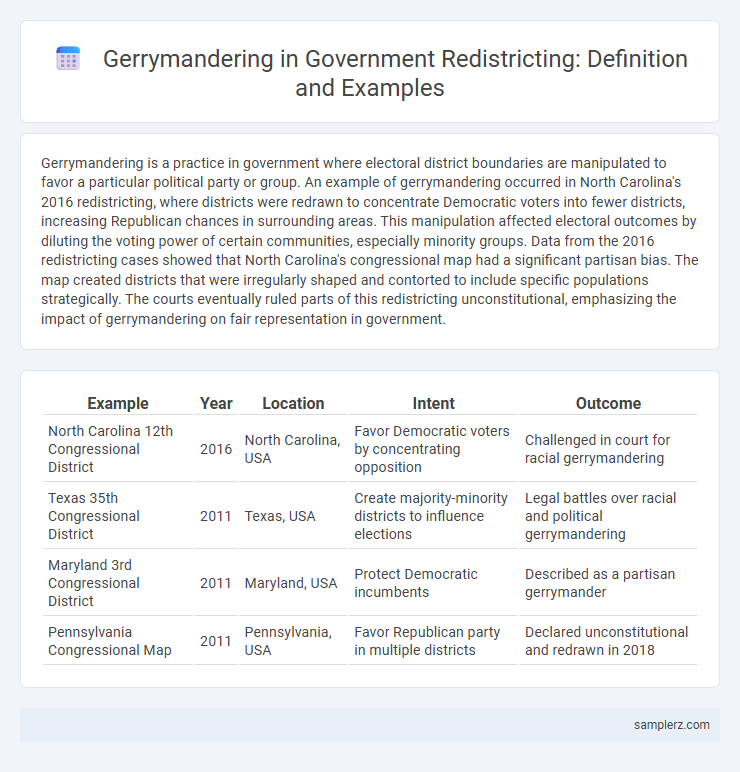Gerrymandering is a practice in government where electoral district boundaries are manipulated to favor a particular political party or group. An example of gerrymandering occurred in North Carolina's 2016 redistricting, where districts were redrawn to concentrate Democratic voters into fewer districts, increasing Republican chances in surrounding areas. This manipulation affected electoral outcomes by diluting the voting power of certain communities, especially minority groups. Data from the 2016 redistricting cases showed that North Carolina's congressional map had a significant partisan bias. The map created districts that were irregularly shaped and contorted to include specific populations strategically. The courts eventually ruled parts of this redistricting unconstitutional, emphasizing the impact of gerrymandering on fair representation in government.
Table of Comparison
| Example | Year | Location | Intent | Outcome |
|---|---|---|---|---|
| North Carolina 12th Congressional District | 2016 | North Carolina, USA | Favor Democratic voters by concentrating opposition | Challenged in court for racial gerrymandering |
| Texas 35th Congressional District | 2011 | Texas, USA | Create majority-minority districts to influence elections | Legal battles over racial and political gerrymandering |
| Maryland 3rd Congressional District | 2011 | Maryland, USA | Protect Democratic incumbents | Described as a partisan gerrymander |
| Pennsylvania Congressional Map | 2011 | Pennsylvania, USA | Favor Republican party in multiple districts | Declared unconstitutional and redrawn in 2018 |
Notorious Gerrymandering Cases in U.S. History
The 1812 Massachusetts redistricting engineered by Governor Elbridge Gerry gave rise to the term "gerrymandering," as it manipulated district boundaries to favor the Democratic-Republican Party. In the 2010s, North Carolina faced multiple legal battles over extreme partisan gerrymandering, with courts ruling that districts were drawn to disproportionately benefit Republicans. Another infamous case is the 1990s Texas redistricting, where racial and political lines were strategically redrawn to dilute minority voting power and secure incumbents' seats.
Classic Examples of Partisan Redistricting
Classic examples of partisan gerrymandering include North Carolina's 2016 congressional map, where districts were drawn to favor Republicans by concentrating Democratic voters into a few districts while spreading others thinly across multiple districts. Another notable case is Maryland's 2011 redistricting, in which Democratic lawmakers manipulated district boundaries to dilute Republican voting strength, securing a significant advantage in congressional representation. These instances highlight the strategic manipulation of electoral district lines to entrench political power and undermine electoral fairness.
Famous State-Level Gerrymanders: A Closer Look
The 2010 redistricting in North Carolina exemplifies famous state-level gerrymanders, where district boundaries were manipulated to favor Republican candidates by concentrating Democratic voters into few districts. This tactic, known as "packing," effectively diluted the electoral influence of opposing parties across multiple districts. Courts have repeatedly challenged these maps, highlighting the ongoing controversy and legal battles surrounding partisan gerrymandering at the state level.
Historical Instances of Racial Gerrymandering
Historical instances of racial gerrymandering include the 1986 case of Shaw v. Reno, where North Carolina's redistricting created oddly shaped districts to dilute Black voting strength. The Supreme Court ruled that such racial gerrymandering violated the Equal Protection Clause of the 14th Amendment, setting a precedent in electoral law. Similar cases have since exposed how state legislatures manipulated district boundaries to weaken minority representation.
Recent Gerrymandering Controversies and Court Rulings
Recent gerrymandering controversies have centered on states like North Carolina and Texas, where redistricting maps were challenged for diluting minority voting power and entrenching partisan advantage. Courts have ruled against several maps, such as the 2022 North Carolina legislative map, deeming them unconstitutional due to racial and partisan gerrymandering. These rulings underscore ongoing judicial scrutiny aimed at ensuring fair representation under the Voting Rights Act and the Equal Protection Clause.
Manipulation of District Boundaries: Key Examples
The 2010 redistricting in North Carolina illustrates gerrymandering through district boundary manipulation aimed at diluting African American voting power, which led to multiple legal challenges. In Pennsylvania, the 2011 map was ruled unconstitutional for partisan gerrymandering as it favored Republican candidates by reshaping districts to pack Democratic voters. Wisconsin's 2011 redistricting similarly manipulated boundaries to create a significant Republican advantage, prompting widespread debates on fair representation and electoral integrity.
High-Profile Legal Battles Over Gerrymandering
The 2019 Supreme Court case Rucho v. Common Cause addressed partisan gerrymandering in North Carolina's congressional districts, ruling that federal courts lack jurisdiction over political gerrymandering claims. In Wisconsin, Whitford v. Gill challenged the state's legislative maps, highlighting extreme partisan bias favoring Republicans, though the case was eventually remanded on technical grounds. These high-profile legal battles underscore ongoing conflicts over redistricting and the struggle to balance political representation and fair electoral processes.
Gerrymandered Districts: Before and After Maps
Gerrymandered districts, such as North Carolina's 12th Congressional District, demonstrate stark contrasts between before and after redistricting maps, where boundaries are manipulated to favor a specific party. These maps reveal irregularly shaped districts designed to concentrate or dilute voting power, undermining fair representation and skewing election outcomes. Analyzing these transformations through geographic information system (GIS) data highlights the impact of gerrymandering on electoral competitiveness and voter equity.
Political Impacts of Notable Gerrymandering Efforts
The 2010 midterm elections highlighted the political impacts of gerrymandering, with states like North Carolina and Pennsylvania redrawing districts to favor Republicans, significantly affecting congressional balance. These manipulations diluted minority voting power, undermined fair representation, and contributed to increased political polarization at both state and national levels. Courts have repeatedly challenged such maps, emphasizing the ongoing tension between legal standards and partisan redistricting efforts.
Lessons Learned from Prominent Redistricting Abuses
The 2010 redistricting in North Carolina exemplifies gerrymandering abuses, where maps were drawn to disproportionately favor Republicans, undermining fair representation. The U.S. Supreme Court's 2019 ruling in Rucho v. Common Cause highlighted the challenges in adjudicating partisan gerrymandering claims, emphasizing the need for independent commissions. Lessons learned underscore the importance of transparency, nonpartisan map-drawing bodies, and judicial oversight to uphold electoral integrity and protect voter equality.

example of gerrymander in redistricting Infographic
 samplerz.com
samplerz.com